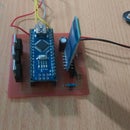Introduction: Adjustable Power Supply
WARNING: This project includes high voltage, thus you should be careful.
I made a variable power supply to use at home. It can provide 17V up to 3A. You can make your own power supply by following the steps, to use at home.
Step 1: Circuit Diagram
- Firstly inputs connect to the transformer. I used the approximately 65W transformer. If we make simply calculation( Power=Current*Voltage) we can estimate how many watts we need.
- Then I build a rectifier bridge with diodes. In this way we can obtain direct current.
- Next step is filtering.I used 3300 uf capacitor for filtering.If you use 2*2200 uf (parallel) it can be better.
- I used lm350 in my circuit.LM350 creates a difference 1.25v between input and output. So we have to calculate R1 and Rv1 to adjustable our ouput Vout= 1.25 V(1+Rv1/R1)+Iadj*Rv1. Our power calculation is P=Current*(Vin-Vout).
- D5,D6 and D7 are protection diodes.They prevent the capacitors from the discharging through low current points into the regulator.
- C1 is the input bypass cap.It can be A 0.1 F disc or 1 F tantalum.
- C7 filters noise on pot. You should not choose upper than 20uF.
- For LDO regulators they must consume a power between a range. It was 10ma for my lm350 because of this reason I used a 5w stone resistor. If you chose 10w it could be better.
I used the second circuit for dc fan with an extra output.
Step 2: COMPONENT LIST
- Transformer (65 W)
- Lm350
- 1n5401 diodes*4
- 3300 uf 50v capacitor
- 0.1uf film capacitor
- 1n4007 diodes *3
- 2.5k pot
- 2.2uf electrolytic cap
- 120r 1w
- 22uf electrolytic 50v cap
- 100uf electrolytic 50v cap
- 4u7 tantalum 35v cap
- 150r 5w stone resistor(you should calculate for your own circuit)
- Glass fuse (3A-3.3A)
Second pcb
- led
- fan
- 1n4007 diodes*f
- 470 uf 35v electrolitic cap
Step 3: Making PCB
After I draw the PCB I printed on printer then I print on the copper plaque. After that, I modified some ways. You should be sure ways of PCB can carry 3A. After that, I put on acid.
Step 4: Solder Mask (Optionally)
After I dissolve the copper in acid, I made solder mask on my PCBs.Making a solder mask is the little bit tricky but it has many benefits. Firstly you can protect from corrosion and you can prevent some short circuit situations. After solder mask, I drill the holes on PCB.
Step 5: Soldering
Soldering is the one of the most important part of this project. You should solder of the components with the data in the datasheet. In my opinion, you should solder the lm350 at last.After the soldering you should check it there is no short circuit.
Step 6: Assembling
When assembling your circuit you shout correct cables. I used one key and glass fuse I connect them each other in a series way and connect on transformer input but they are not in circuit scheme. You should be careful about short circuits otherwise you can blow up your PSU.
Step 7: Power On
If you follow the statements you can make your own PSU to use your projects.











